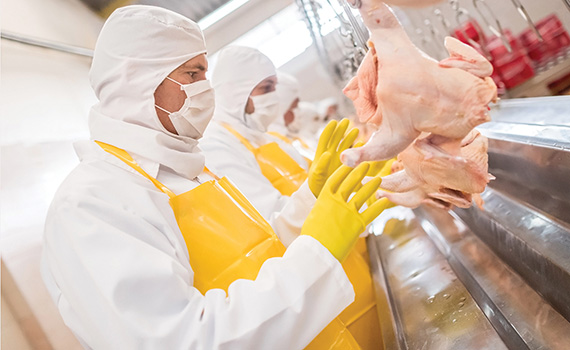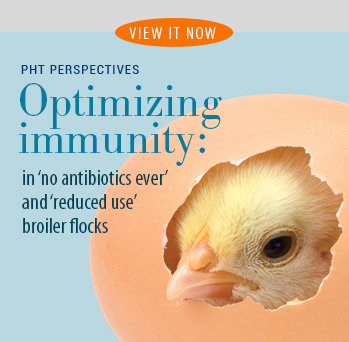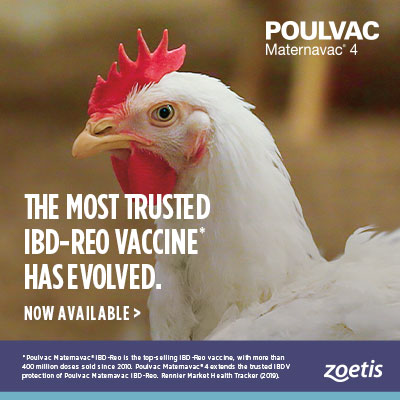Exploring the cause of condemnations can reduce losses

By Lloyd Keck, DVM, ACPV
Senior Technical Services Veterinarian, Zoetis
Recently, I was asked by a major US broiler producer to help figure out the cause of condemnations. This is something I’ve done periodically for over 25 years as a consultant and, for the last several years, on behalf of Zoetis.
Condemnations are among the most frustrating aspects of poultry production. Consider what it takes to produce broilers. There’s housing and managing breeder flocks, the hatchery process and raising chicks on farms. It’s a huge endeavor.
When carcasses are rejected at processing, all the time and money that went into production is lost. Couple that with even slight increases in the condemnation rate, and the losses really mount.
Reasons for rejection
USDA’s Food Safety and Inspection Service (FSIS) reports a post-mortem condemnation rate of 0.96% for federally inspected chickens in 2015, up from 0.94% in 2014.1 In my experience, a 1% condemnation rate isn’t uncommon and a 2% rate would be considered extreme.
There’s a long list of reasons chicken carcasses or parts are rejected upon inspection, but it’s generally when USDA inspectors find fecal contamination or signs of disease. Sometimes, it’s not readily apparent if a carcass should be rejected or not, and inspectors understandably err on the side of food safety.
Among diseases that lead to rejection, septicemia/toxemia tops the list. It’s a catchall category for birds with severe generalized conditions. I also see a lot of airsacculitis, as well as ascites — a fluid buildup in the abdomen.
Inflammatory process (IP) is a common finding upon inspection and doesn’t usually result in condemnation of the carcass, but it often results in trimming that can lead to substantial additional losses.
Evaluating the process
When I’m asked to help figure out the cause of condemnations, I start at the beginning of processing. I weigh a sample of birds to check for uniformity.
I consider bird handling and animal welfare because rough handling can adversely affect the carcass. I see if the processing lines are operating correctly. I do a gut check to examine the viscera to make sure feed was withdrawn correctly — about 10 hours before processing. If there’s feed in the intestines, it increases the chances for contamination and condemnation.
Next, I introduce myself to the USDA inspectors and explain why I’m there. I usually invite the USDA veterinarian in charge to join me in reviewing the rejected carcasses that have been tossed into a yellow trash receptacle, where the meat is denatured with a colored dye to ensure it will never be consumed by humans.
For some problems that are localized and don’t affect the entire bird, regulations allow for trimming versus tossing the whole carcass. Inspectors also have the option of setting aside carcasses they aren’t sure about for review by the USDA veterinarian, who makes the final call.
Judgment calls
On my recent visit to a processing plant, I found nothing regarding animal welfare or the slaughter process that would result in condemnations. This day, I worked through two 8-hour shifts with two different inspectors and the USDA veterinarian in charge of each shift.
It was my opinion that over 50% of carcass condemnations were unnecessary. I thought there were some inaccurate judgment calls for septicemia/toxemia, and there was a second group condemned for IP that I believed could be salvaged with trimming.
By reviewing the inspector’s decisions and explaining my findings, it was possible to reduce the condemnation rate from 1% to 0.5%. For a producer processing 1 million 7-pound birds per week at 85 cents per pound, this reduction in condemnations amounts to a savings of $1,160,250 per year.
It’s important to keep in mind that the job of poultry inspection is grueling work, that an inspector has only a few seconds to examine each bird and the inspector has a responsibility for food safety. It’s my experience, however, that some inspectors would welcome and benefit from additional training by a poultry veterinarian. It can be difficult to make judgment calls in a split second, especially when a problem with a carcass isn’t black and white. Additional training could help inspectors be more confident and make more accurate decisions.
Working in partnership
This process of exploring the reasons for condemnation can go a long way toward reducing losses, as my most recent day at the processing plant illustrates. Over the years I’ve heard complaints from within the poultry industry that USDA-FSIS was a “command and control” operation, but that’s changed. USDA has made an effort to work in partnership with producers.
I encourage producers to cultivate and maintain a cordial relationship with USDA inspectors and veterinarians. Periodically working shoulder-to-shoulder, looking at condemnations together and agreeing or disagreeing keeps the process more centered. It’s a good idea to also enlist the participation of the USDA veterinarian for review of carcasses set aside when inspectors aren’t sure what to do.
Look at live production
There’s another way that review of processing plant procedures and rejected carcasses can help reduce condemnations. If problems such as bird handling during processing aren’t the cause, the findings might point to live-production problems that aren’t apparent by just walking around a poultry farm.
If bird size and weight are inconsistent, that can suggest problems with subclinical coccidiosis and other diseases that can hurt flock health, welfare and performance.
A high incidence of condemnations due to airsacculitis which, as I mentioned, I see a lot of, can be due to poor house ventilation, but it’s often caused by opportunistic Escherichia coli infection that leads to septicemia. E. coli can take hold in broilers affected with variant strains of infectious bronchitis, rendering a one-two punch to the bird. The solution may be improved management of infectious bronchitis and perhaps vaccination against E. coli.
Ascites might be due to husbandry practices, the diet or conditions that reduce oxygen. If the cause is heart failure that results from fast growth, lighting programs probably need changing.
When there’s a high rate of carcasses that need to be trimmed due to IP, producers will want to rule out wet floor conditions. Another possible cause is poor intestinal health due to coccidiosis that sometimes leads to necrotic enteritis. Improved coccidiosis management may be in order.
Getting a good handle on the cause of condemnations and the need for trimming includes both exploring live production problems as well as working with USDA inspectors.
Everyone involved in the poultry industry — veterinarians, the poultry production staff, the processing staff as well as inspectors — has the same objective, which is to produce a safe and wholesome product for consumers. It’s also essential that poultry producers remain sustainable, and that requires minimizing losses wherever possible. These goals can be achieved if we all keep them in mind.
See related articles:
Observe, judge, act — Veterinarian offers practical tips for reducing carcass condemnations
Condemnations, mortality shift focus to E. coli vaccination in some broiler flocks
E. coli in broilers: Its costly impact on condemnations and mortality
Salmonella prevention requires teamwork between production and processing
Good communication key to protecting poultry parts during FSIS inspection
Editor’s note: The opinions and recommendations presented in this article are the author’s and are not necessarily shared by the editors of Poultry Health Today or its sponsor.
1USDA Poultry Slaughter 2015 Summary.
NA-00739
Posted on January 25, 2017
 We’re glad you’re enjoying
We’re glad you’re enjoying




















